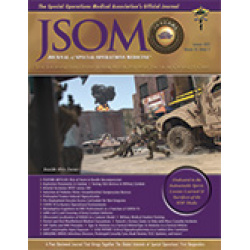Warning: Tourniquets Risk Frostbite in Cold Weather
Kragh JF, O'Conor DK 23(1). 9 (Journal Article)
We sought to better understand the frostbite risk during first-aid tourniquet use by reviewing information relevant to an association between tourniquet use and frostbite. However, there is little information concerning this subject, which may be of increasing importance because future conflicts against near-peer competitors may involve extreme cold weather environments. Historically, clinical frostbite cases with tourniquet use occurred in low frequency but in high severity when leading to limb amputation. The physiologic response of vasoconstriction to cold exposure leads to limb cooling and causes a reduction of limb blood flow, but cold-induced vasodilation ensues as periodic fluctuations that increase blood flow to hands and feet. In animal experiments, tourniquet use increased the development of frostbite. Evidence from human experiments also supports an association between tourniquet use and frostbite. Clinical guidance for caregiving to casualties at risk for frostbite with tourniquet use had previously been provided but slowly and progressively dropped out of documents. Conclusions: The cause of frostbite was deduced to be a sufficiently negative heat-transfer trend in local tissues, which tourniquet use may worsen because of decreasing tissue perfusion. An association between tourniquet use and frostbite exists but not as cause and effect. Tourniquet use increased the risk of the cold causing frostbite by allowing faster cooling of a limb because of reduced blood flow and lack of cold-induced vasodilation. Care providers above the level of the lay public are warned that first-aid tourniquet use in low-temperature (<0°C [<32°F]) environmental conditions risks frostbite.


 Español
Español 



